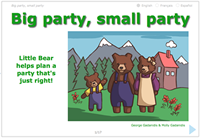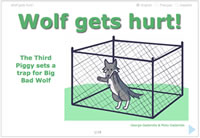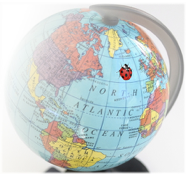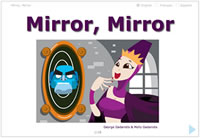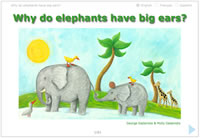MEASUREMENT & GEOMETRY STORIES, K-8
CONCEPTUALLY RICH. EMOTIONALLY ENGAGING. WONDERFUL TO SHARE.
Get PDF of each story for $5 each, in 3 languages (English, French & Spanish), with a detailed lesson plan & powerful instructional strategies. With coding extensions.
13. Big Party, Small Party – $5
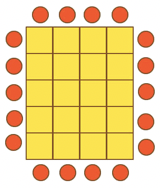 Tables = area & chairs = perimeter?
Tables = area & chairs = perimeter?
Bear helps plan a party that is not too small and not too big, and discovers a relationship between area and perimeter.
Content (Gr. 1-4): area and perimeter as an array of tables with chairs (all around); arrangements with shortest perimeter; optimization — 38 pages
14. Wolf gets Hurt – $5
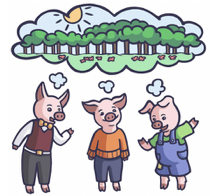 Building biggest pen. Environmental awareness.
Building biggest pen. Environmental awareness.
The Piggies set a trap for Wolf and use math to build his pen. They also realize that their sloppy living habits hurt Wolf’s habitat.
Content (Gr. 2-8): area & perimeter; number arrays; largest rectangular area with 12 metres of fence; optimization — 38 pages
15. Do Parallel Lines Meet? – $5
Piggy and Wolf are running on parallel paths, but are they destined to meet? Piggy discovers that parallel lines aren’t as straight forward as she expected.
Content (Gr. 2-8): straight, curved & parallel lines; lined on a sphere / globe; flat and curved surfaces; latitude & longitude — 28 pages
16. Mirror, Mirror – $5
 Which quilting pattern is the fairest of all?
Which quilting pattern is the fairest of all?
When the Queen’s mirror can’t decide whether her quilt pattern is the fairest of all, the Queen hosts a Quilting Festival.
Content (Gr. 2-6): tessellations; geometric shapes & patterns around us; symmetry — 40 pages
17. How Big is a Billion? – $5
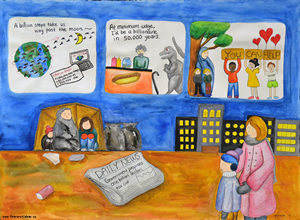 What would you do with a billion dollars?
What would you do with a billion dollars?
Savannah and Tanner meet a homeless family. What could they do to help? What could you do to help?
Content (Gr. 3-8): mathematics of poverty; social justice; modelling & estimating large numbers; measurement benchmarks — 40 pages
18. Why do Elephants have Big Ears? – $5
 Math can explain why elephants have big ears!
Math can explain why elephants have big ears!
Wolf asks, “Why do elephants have big ears?” and Hoodie uses cubes to model elephants of various sizes to discover a neat relationship between surface area and volume.
Content (Gr. 4-8): volume & surface area relationships; patterns in data; rates of growth; tables & graphs — 44 pages
MORE STORIES
- Number (#1-6)
- Pattern & Algebra (#7-12)
- Measurement & geometry (#13-18)
- Data & probability (#19-20)
- Bundles of all 20 stories
